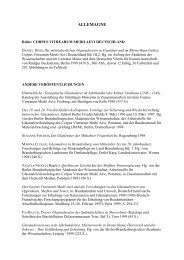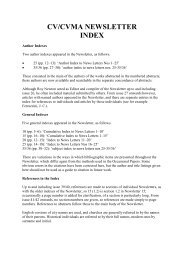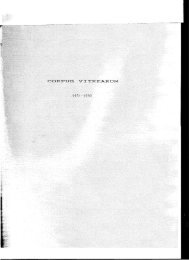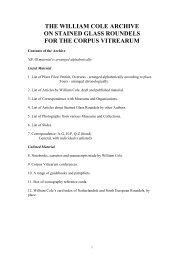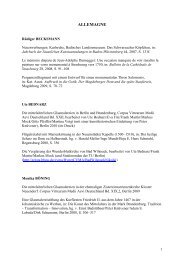BristolConference - Corpus Vitrearum Medii Aevi
BristolConference - Corpus Vitrearum Medii Aevi
BristolConference - Corpus Vitrearum Medii Aevi
Create successful ePaper yourself
Turn your PDF publications into a flip-book with our unique Google optimized e-Paper software.
Prof. Alyce Jordan<br />
(Northern Arizona University, Arizona)<br />
The Relics Window in the Ste-Chapelle: The Politics of Piety and Dynasty<br />
The 'Relics' window has long been noted for its famous portraits documenting the<br />
participation of Louis IX and his family in the Translation of the Crown of Thorns to Paris.<br />
When the Ste-Chapelle glass was restored in the nineteenth century, this window was<br />
effectively redesigned, through the suppression of authentic scenes and the inclusion of<br />
newly made panels, to depict the history of the True Cross and other Passion relics. Within<br />
this narrative framework, the scenes of the royal family have traditionally been understood<br />
as elaborate donor portraits. My investigation of the window's pre-restoration condition,<br />
together with my study of the other narratives depicted in the glass ensemble, suggest that<br />
the window originally contained not a history of the True Cross but, rather, a history of the<br />
kings of France whose formal constructs and thematic emphases mirrored those of the<br />
chapel's surrounding biblical windows. Identification of the 'Relics' window as a visual<br />
chronicle of French royal history invites reconsideration both of the window's role in the<br />
glass ensemble and of the ways in which veneration of Christ's relics, particularly the<br />
Crown of Thorns, resonated within Capetian constructs of dynasty and sacral kingship.<br />
Prof. Fabienne Joubert<br />
(Sorbonne, Paris 4)<br />
La commande laique en France a lafin du Moyen Age: eta: de la question et perspectives<br />
de recherche<br />
Dans le cadre de l'expose, l'auteur evoquera d'abord la courte historiographie de la<br />
question puis la nature des sources sur lesquelles peut se fond er une reflexion relative a la<br />
commande Iaique.<br />
Apres avoir evoque les lieux privilegies par cette commande: dans les batiments religieux,<br />
ou ils sont evidemment le plus souvent conserves, il s'agira de s'interesser particulierernent<br />
a cette derniere, de loin la mieux documentee, par l'enonce de quelques questions:<br />
- quelles categories sociales sont impliquees dans cette commande?<br />
- quelles relations les lient au clerge?<br />
- dans quelle mesure les lares s'impliquent-ils: dans le choix de la localisation de leur<br />
verriere, pour la definition du programme iconographique, pour le choix des peintres<br />
et peintres-verriers engages dans la realisation de leur verriere?<br />
- comment se font-ils representer?<br />
Lay Patronage in late Medieval<br />
France<br />
Within the framework of the talk, the speaker will first review the brief historiography of<br />
the issue, then the nature of the sources upon which a consideration of lay patronage can<br />
be based.<br />
After outlining the places benefiting from this patronage; in religious buildings, where they<br />
are obviously most often preserved, it will be a question of being interested particularly in<br />
the latter, by far the most often documented, through the exposition of these questions:<br />
- Which social categories were involved in this patronage?<br />
- What were their relations with the clergy?<br />
- To what extent were lay donors involved in: choosing the location of their glass;<br />
defining the iconographic programIl!-e;choosing the painters and glassmakers to be<br />
involved?<br />
- How did they have themselves represented?<br />
10



